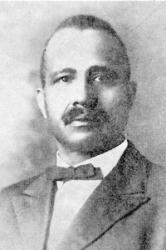
1842 - 1906 Person Name: Rev. George Matheson Scripture: Hebrews 3:7 Author of "The New Day" in Sacred Songs Matheson, George, D.D., was born at Glasgow, March 27, 1842, and although deprived of his eyesight in youth he passed a brilliant course at the University of Edinburgh, where he graduated M.A. in 1862. In 1868 he became the parish minister at Innellan; and subsequently of St. Bernard's, Edinburgh. He was the Baird Lecturer in 1881, and St. Giles Lecturer in 1882. He has published several important prose works. His poetical pieces were collected and published in 1890 as Sacred Songs, Edinburgh: W. Blackwood. In addition to his hymn "O Love that wilt not let me go" (q. v.), four others from his Sacred Songs are in Dr. A. C. Murphey's Book of Common Song, Belfast, 1890.
--John Julian, Dictionary of Hymnology, Appendix, Part II (1907)
=======================
Matheson, G., p. 1579, i. In addition to Dr. Matheson's hymn, "O Love, that wilt not let me go," p. 1583, i,, the following from his Sacred Songs, 1890, have come into common use since 1892:—
1. Come, let us raise a common song. Brotherhood.
2. Father divine, I come to Thee. Strength for Life. This, in Horder's Worship Song, 1905, is altered to”Saviour divine, I come to Thee."
3. Gather us in, Thou Love that fillest all. One in Christ.
4. Jesus, Fountain of my days. Christian's Polestar.
5. Lend me, O Lord, Thy softening cloud. The Fire and the Cloud. In the Sunday Magazine, 1875.
6. Lord, Thou hast all my frailty made. Strength for the Day.
7. Make me a captive, Lord. Christian Freedom.
8. There are coming changes great. The Glad New Time.
9. Three doors there are in the temple. Prayer.
Dr. Matheson informed us that these hymns, together with the rest of his Sacred Songs, 1890, were written at Bow, Dumbartonshire, in 1890. The 3rd ed. of the Sacred Songs was published in 1904. He died suddenly at Avenelle, North Berwick, Aug. 28, 1906.
--John Julian, Dictionary of Hymnology, New Supplement (1907)
George Matheson


 My Starred Hymns
My Starred Hymns





